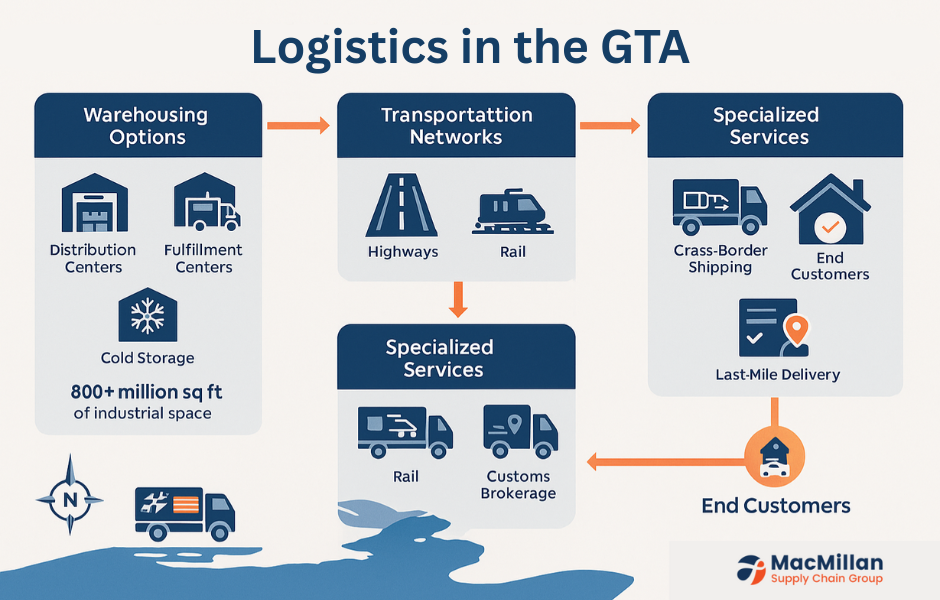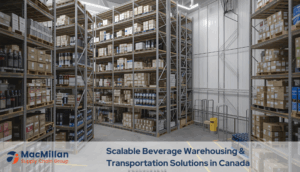A Quick Summary and Overview
The Greater Toronto Area (GTA) stands as Canada’s premier logistics hub, offering unparalleled advantages for businesses seeking efficient supply chain solutions. With extensive warehousing facilities, robust transportation networks, and cutting-edge technology integration, the GTA provides the perfect ecosystem for seamless logistics operations. This comprehensive guide explores everything from warehousing options and distribution services to third-party logistics providers and cross-border shipping solutions. Whether you’re a small business or large enterprise, understanding the GTA’s logistics landscape is essential for optimizing your supply chain, reducing costs, and delivering exceptional customer experiences in today’s competitive marketplace.
Understanding Logistics in the GTA
The Greater Toronto Area (GTA) serves as the beating heart of Canada’s supply chain network, processing billions of dollars in goods movement annually. As Ontario’s economic powerhouse, this region combines strategic geographic positioning, world-class infrastructure, and logistics expertise to create an unmatched environment for efficient supply chain operations.
But what makes logistics in the GTA so special? It’s the perfect combination of location, resources, and innovation. With access to major highways, international airports, rail connections, and proximity to the US border, the GTA offers businesses unprecedented connectivity. Add to this the concentration of warehousing facilities, third-party logistics providers, and transportation services, and you have a complete ecosystem designed to move products quickly and efficiently.
Whether you’re shipping across Ontario or internationally, understanding how to leverage the GTA’s logistics advantages can transform your business operations.
The GTA’s Strategic Advantage for Supply Chain Operations

The Greater Toronto Area’s position as Canada’s logistics powerhouse isn’t accidental. It’s built on a foundation of strategic advantages that make it the ideal location for warehousing in Toronto and beyond.
First, consider the geographic positioning. The GTA sits at the crossroads of major transportation routes, with Highway 401 (North America’s busiest highway) running through its heart. This central location provides easy access to over 135 million consumers within a day’s drive, making it perfect for businesses serving both Canadian and US markets.
The region’s infrastructure further enhances its appeal. Toronto Pearson International Airport handles over 45% of Canada’s air cargo, while the area’s extensive rail network connects to all major North American markets. This multi-modal connectivity creates flexibility for shippers and helps optimize the Ontario supply chain.
Population Density and Market Access
With over 7 million residents, the GTA represents Canada’s largest consumer market. This population density creates natural efficiencies for last-mile delivery operations, allowing businesses to reach more customers with fewer resources.
The concentration of businesses also generates economies of scale. With hundreds of Toronto logistics companies competing for business, companies benefit from competitive pricing and innovative service offerings. This healthy competition drives continuous improvement in the sector, with providers constantly developing new solutions to address evolving market needs.
For businesses looking to optimize their supply chain, the GTA offers unmatched strategic advantages that can translate directly to bottom-line benefits.
Warehousing Solutions Across the GTA
Warehousing forms the backbone of logistics in the GTA, with options ranging from basic storage facilities to sophisticated fulfillment centers. The region boasts over 800 million square feet of industrial space, offering solutions for businesses of every size and industry.
Types of Warehousing Facilities
The GTA warehousing solutions landscape includes several specialized options:
- Distribution centers: Large-scale facilities designed for high-volume throughput, often exceeding 200,000 square feet
- Fulfillment centers: Technology-driven warehouses optimized for e-commerce operations with advanced picking and packing capabilities
- Cold storage facilities: Temperature-controlled environments for food, pharmaceuticals, and other sensitive products
- Bonded warehouses: Secure locations for storing imported goods before customs duties are paid
- Cross-dock facilities: Transit points where incoming shipments are immediately transferred to outbound transportation
These facilities are strategically positioned throughout the region, with concentrations in Mississauga, Brampton, Vaughan, and Markham. Each area offers unique advantages in terms of highway access, proximity to Pearson Airport, and available labor pools.
Modern warehousing in Toronto has evolved beyond simple storage. Today’s facilities offer value-added services including inventory management, order fulfillment, kitting and assembly, labeling, and returns processing. Many warehouses now feature state-of-the-art technology including automated storage and retrieval systems, robotics, and real-time inventory tracking capabilities that integrate seamlessly with business management platforms.
Transportation Networks and Distribution Capabilities
The GTA’s transportation infrastructure creates a seamless Canadian transportation network that supports efficient movement of goods throughout the region and beyond. This robust system enables businesses to optimize their distribution strategies while maintaining reliability and cost-effectiveness.
Highway Infrastructure
The 400-series highways form the arterial system of the GTA’s logistics network. Highway 401 serves as the main east-west corridor, while Highways 400, 404, and 427 provide north-south connectivity. The Highway 407 Express Toll Route offers an alternative for time-sensitive shipments, allowing trucks to bypass congestion during peak periods.
This extensive highway network supports Ontario trucking services that connect the GTA to all major Canadian markets and US border crossings. For businesses requiring regular shipments, dedicated trucking routes provide predictable transit times and reliable service levels.
Intermodal Connections
Beyond road transportation, the GTA offers exceptional intermodal capabilities. CN and CP Rail operate major terminals in Brampton and Vaughan, facilitating container movements between rail, road, and sea. These intermodal facilities handle thousands of containers daily, supporting both domestic and international freight movements.
For air cargo, Toronto Pearson International Airport serves as Canada’s primary gateway, with specialized facilities for handling everything from express parcels to oversized freight. The airport’s cargo village houses freight forwarders, customs brokers, and ground handlers who work together to ensure smooth processing of international shipments.
This integrated transportation ecosystem creates flexibility and resilience for supply chains operating in the GTA.
Third-Party Logistics Providers in the GTA
The GTA hosts a diverse ecosystem of third-party logistics providers offering specialized services to meet virtually any supply chain requirement. These 3PL partners range from global enterprises with extensive networks to niche operators focused on specific industries or service types.
Services Offered by Leading 3PLs
Toronto logistics companies typically provide a comprehensive suite of services including:
- Warehousing and inventory management
- Order fulfillment and e-commerce operations
- Transportation management and freight brokerage
- Cross-border shipping and customs clearance
- Returns processing and reverse logistics
- Supply chain consulting and optimization
What distinguishes top-tier providers is their ability to integrate these services into cohesive solutions tailored to each client’s unique requirements. Rather than offering one-size-fits-all packages, leading 3PLs work consultatively with clients to develop customized supply chain strategies.
Technology Integration
Modern third-party logistics in the GTA is increasingly technology-driven. Advanced providers offer sophisticated platforms that provide real-time visibility across the entire supply chain. These systems enable inventory tracking, order management, transportation planning, and performance analytics through unified dashboards accessible to both the 3PL and their clients.
For businesses seeking to optimize their logistics operations, partnering with an established GTA-based 3PL offers significant advantages. These providers bring deep local knowledge, established carrier relationships, and economies of scale that would be difficult for individual companies to replicate internally. Their expertise becomes particularly valuable when navigating complex requirements like cross-border shipping or specialized handling protocols
Challenges in GTA Logistics Operations
Despite its many advantages, logistics in the GTA presents several significant challenges that businesses must navigate:
Infrastructure Congestion
The GTA’s highways experience some of North America’s worst traffic congestion, with average speeds on Highway 401 dropping below 35 km/h during peak periods. This congestion creates unpredictable transit times that complicate delivery scheduling and resource planning. For time-sensitive shipments, delays can ripple throughout the supply chain, affecting production schedules and customer satisfaction.
Real Estate Constraints
Warehousing space in the GTA comes at a premium, with industrial vacancy rates hovering around 0.9% in prime areas. This space scarcity drives up leasing costs, with rates increasing by over 40% in the past five years. For growing businesses, securing appropriate facilities often requires long-term planning and significant capital investment.
Labor Market Challenges
The logistics sector faces persistent labor shortages, particularly for skilled positions like truck drivers, warehouse managers, and supply chain analysts. Competition for talent drives up wages and creates retention challenges. The seasonal nature of many logistics operations further complicates workforce planning, requiring flexible staffing solutions.
Cross-Border Complexities
While proximity to the US border creates opportunities, cross-border shipping involves navigating complex customs requirements, duty calculations, and regulatory compliance issues. Documentation errors or incomplete information can lead to costly delays and potential penalties.
Technology Integration Hurdles
As supply chains become increasingly digitized, businesses face challenges in integrating disparate systems across multiple partners. Legacy systems may not communicate effectively with modern platforms, creating information silos that undermine visibility and coordination efforts.
MacMillan Supply Chain’s Comprehensive Solutions
At MacMillan Supply Chain Group, we’ve developed innovative approaches to address the common challenges of logistics in the GTA, delivering seamless supply chain operations for businesses of all sizes.
Strategic Location Network
To overcome infrastructure congestion, we’ve established a strategic network of facilities throughout the GTA, positioned to provide optimal access to major transportation corridors while avoiding the most congested areas. Our Toronto distribution center locations are carefully selected based on traffic pattern analysis, proximity to key highways, and accessibility to intermodal facilities.
This distributed network allows us to implement zone-based fulfillment strategies, positioning inventory closer to end customers and reducing transit times. For time-sensitive deliveries, we utilize advanced route optimization technology that incorporates real-time traffic data to identify the most efficient delivery paths.
Flexible Warehousing Solutions
Recognizing the challenges of securing adequate warehousing in Toronto, we offer scalable solutions that grow with your business. Our shared warehousing model provides access to premium facilities without requiring long-term leases or significant capital investment. Clients can scale their space utilization up or down based on seasonal needs or growth patterns.
Our facilities feature modular racking systems that can be reconfigured to accommodate changing product mixes or storage requirements. This flexibility extends to our service offerings, with options ranging from basic pallet storage to comprehensive fulfillment services including picking, packing, and value-added processing.
Technology-Driven Operations
MacMillan has invested heavily in supply chain management technology that creates seamless visibility across all logistics operations. Our proprietary platform integrates warehouse management, transportation planning, order processing, and analytics into a unified system accessible through a client portal.
This technology enables:
- Real-time inventory tracking across multiple facilities
- Automated order routing to optimal fulfillment locations
- Predictive analytics for demand forecasting and resource planning
- Integrated documentation for cross-border shipping
- Performance dashboards with customizable KPIs
For e-commerce fulfillment, our system integrates directly with major shopping carts and marketplaces, automatically processing orders as they’re received and providing tracking information to both merchants and end customers.
Cross-Border Expertise
Our specialized cross-border shipping team navigates the complexities of US-Canada trade with precision and efficiency. We maintain relationships with trusted customs brokers at all major crossing points and pre-clear documentation to minimize border delays. Our compliance team stays current on regulatory changes, ensuring all shipments meet the latest requirements.
Specialized Industry Solutions
Beyond general logistics services, MacMillan offers tailored solutions for industries with unique requirements:
- Food and beverage: Temperature-controlled facilities with food safety certification
- Retail: Specialized merchandising services including ticketing and display building
- Healthcare: Validated environments for medical devices and pharmaceuticals
- Industrial: Capabilities for handling oversized and heavy equipment
By combining industry expertise with operational excellence, we deliver solutions that address the specific challenges of each sector while maintaining the highest standards of efficiency and reliability.
Optimizing Your GTA Logistics Strategy
Navigating logistics in the GTA doesn’t have to be overwhelming. By implementing these strategic approaches, you can transform potential challenges into competitive advantages:
Start with a Comprehensive Assessment
Begin by evaluating your current supply chain operations, identifying pain points and opportunities for improvement. Analyze your order patterns, inventory requirements, and customer delivery expectations to establish clear performance benchmarks.
Develop a Multi-Carrier Strategy
Rather than relying on a single transportation provider, develop relationships with multiple carriers specializing in different service types. This approach provides flexibility during peak periods and creates contingency options when disruptions occur.
Leverage Technology
Implement systems that provide real-time visibility across your supply chain. Even basic tracking capabilities can significantly improve coordination and customer communication.
Consider Strategic Partnerships
For many businesses, partnering with an established third-party logistics provider offers the most effective path to supply chain excellence. MacMillan Supply Chain Group brings decades of experience navigating the complexities of the GTA logistics landscape, providing clients with immediate access to infrastructure, technology, and expertise that would take years to develop internally.
Take the Next Step
Ready to transform your logistics operations? Contact MacMillan Supply Chain Group today for a complimentary supply chain assessment. Our team will analyze your current operations and develop a customized solution that addresses your specific challenges while positioning your business for future growth.
Frequently Asked Questions About Logistics in the GTA
The Greater Toronto Area offers several strategic advantages for logistics operations: central location with access to 135+ million consumers within a day's drive, extensive transportation infrastructure including major highways and Canada's largest airport, proximity to US border crossings, and a concentrated market of over 7 million residents. These factors combine to create efficiencies in both distribution and last-mile delivery operations, making the GTA an optimal hub for Canadian and North American supply chains.
Seasonal factors significantly impact GTA logistics operations. Winter weather conditions can cause transportation delays, particularly from December through March when snowstorms may affect highway travel and airport operations. The holiday shopping season (October through December) creates peak demand for warehousing and transportation services, often requiring advance capacity planning. Summer construction season (May through September) affects traffic patterns and may necessitate route adjustments for time-sensitive deliveries.
Third-party logistics providers offer several advantages: access to established infrastructure without capital investment, scalable capacity that flexes with business needs, specialized expertise in areas like customs compliance and transportation optimization, economies of scale that reduce per-unit handling costs, and advanced technology platforms that provide supply chain visibility. For most businesses, 3PLs deliver superior service levels at lower total costs than equivalent in-house operations.
Cross-border shipping from the GTA typically involves several steps: preparation of commercial documentation (commercial invoice, NAFTA/USMCA certificates), customs broker engagement, carrier selection, and coordination of border crossing procedures. Experienced logistics providers maintain relationships with customs brokers and carriers specializing in cross-border movements, ensuring smooth processing at major crossings like Windsor-Detroit, Niagara Falls, and Fort Erie-Buffalo.
Essential technology for GTA logistics includes warehouse management systems (WMS) for inventory control and order processing, transportation management systems (TMS) for carrier selection and route optimization, real-time tracking capabilities for shipment visibility, integration platforms that connect with e-commerce systems and marketplace channels, and analytics tools that provide actionable insights on performance metrics and improvement opportunities.
Last-mile delivery in the GTA is evolving rapidly with innovations including: micro-fulfillment centers positioned in urban areas for faster delivery, alternative delivery options like secure parcel lockers and retail pickup points, specialized vehicle fleets including electric vans and cargo bikes for urban deliveries, and technology-enabled services offering real-time tracking and precise delivery windows to improve customer experience.
Businesses with variable inventory requirements can access several flexible warehousing solutions in the GTA: shared warehousing with pay-for-space-used models, short-term leasing options for seasonal peaks, on-demand warehousing platforms that connect businesses with available space, and 3PL partnerships that offer scalable capacity without long-term commitments.
Specialized products receive tailored handling through: temperature-controlled facilities for food and pharmaceuticals, secured areas for high-value items, specialized equipment for oversized or heavy products, hazardous materials handling with appropriate certifications and safety protocols, and customized packaging solutions for fragile or uniquely shaped items.
Sustainability in GTA logistics includes: electric and alternative-fuel delivery vehicles, optimized routing to reduce mileage and emissions, energy-efficient warehousing with LED lighting and solar installations, packaging reduction programs that minimize material usage, and consolidated shipping options that maximize trailer utilization and reduce total trips.
Sustainability in GTA logistics includes: electric and alternative-fuel delivery vehicles, optimized routing to reduce mileage and emissions, energy-efficient warehousing with LED lighting and solar installations, packaging reduction programs that minimize material usage, and consolidated shipping options that maximize trailer utilization and reduce total trips.




